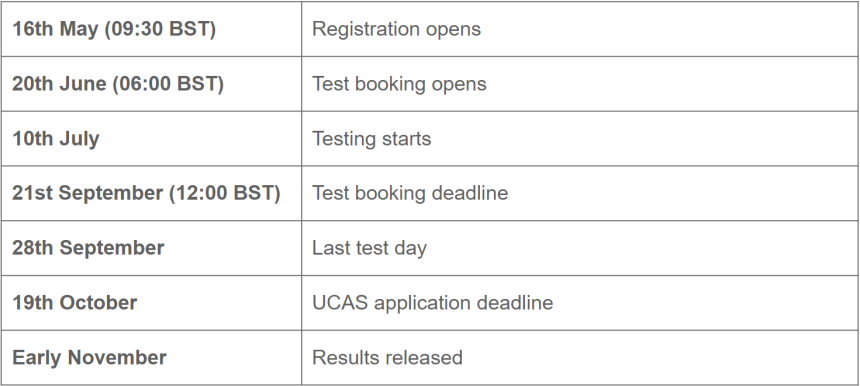Contents:
- What are the UCAT and BMAT?
- When do the BMAT and UCAT take place?
- How much does it cost to sit the UCAT and BMAT?
- Should you take the UCAT or BMAT?
- Should you take both the UCAT and BMAT?
- How do you know if you’re likely to be better at the UCAT or BMAT?
- Top tips for the UCAT and BMAT
- When will you receive your UCAT and BMAT results?
- Final tips
Medical courses are some of the most competitive university courses to get into. With more students than ever getting top grades, achieving excellent A Level results is often not enough to secure a coveted interview slot. A good UCAT and/or BMAT score is necessary to help you stand out. Universities use UCAT and BMAT scores in conjunction with a student’s UCAS application to decide whether to invite them to an interview.
In this article, I’ll explore how each test works and give you tips to help you excel.
What are the UCAT and BMAT?
The BMAT and UCAT (previously UKCAT) are the admissions exams required for applying to medical school, taken in the summer or autumn during the year of application.
The UCAT is a multiple choice exam completed on a computer. It has questions across five subtests. Four sections test your cognitive skills and the final section tests your situational judgement:
- Verbal reasoning
- Quantitative reasoning
- Decision making
- Abstract reasoning
- Situational judgement test
The BMAT tests on a broader range of subjects. It has three sections:
- Section 1 is an aptitude test
- Section 2 covers scientific knowledge and maths
- Section 3 is an essay question
You can watch a mini introduction to the UCAT and BMAT test in PMT’s Getting into Medicine Conference on YouTube.
When do the BMAT and UCAT take place?
UCAT 2023 key dates

You can find more information about the UCAT on the UCAT website.
BMAT 2023 key dates

You can find more information about the BMAT on the Cambridge Assessment website.
How much does it cost to sit the UCAT and BMAT?
Pricewise, they’re pretty similar: the UCAT costs £70 (UK) and £115 (non-UK) whilst the BMAT is £78 (UK/EU) and £104 (non-UK/EU).
If you’re struggling to cover the fees then there are schemes and bursaries available for each test. To be eligible, you’ll need to meet specific criteria:
Should you take the UCAT or BMAT?
Different universities require different exams, so you should research the universities you are interested in applying to and find out their application requirements before deciding which tests you need to sit.
The majority of medical schools require applicants to sit the UCAT. Oxford, Cambridge, University College London (UCL), Lancaster, Imperial, and Brighton & Sussex Medical School (BSMS) are the only schools currently using the BMAT.
It’s important to note that the BMAT is being withdrawn in 2024. Students applying this year will still have to sit the BMAT for the above-mentioned universities.
It is not yet clear what will be used instead for the 2024/2025 application cycle, but it is possible that these universities will switch to the UCAT (like Leeds has already done this year) or introduce their own specific entrance exams.

Should you take both the UCAT and BMAT?
If you’re not sure which universities you want to apply to, then it’s worth sitting both tests to keep your options open.
Aim to spend roughly an equal amount of time preparing for both the UCAT and BMAT. However, if you’re set on attending a specific university, or find one of the tests significantly easier than the other, you can allocate more preparation time to one test accordingly.
If the universities which require the BMAT aren’t on your short list, then you shouldn’t sit it and should instead focus your efforts on just the UCAT.
How do you know if you’re likely to be better at the UCAT or BMAT?
As the format and content of each exam are so different, the best thing to do is to take mock tests to gauge your abilities in each test. You can find a bank of questions and solutions on Physics & Maths Tutor.
Remember, you’re unlikely to get amazing results on your first try with no revision or practice, but it will give you an idea of what to expect and what you will need to work on if you decide to sit each test.
Some people find the BMAT tricky if they haven’t taken physics for GCSE or if they struggle with essay writing. Some find the online format of the UCAT and the style of questions more difficult to get to grips with. However, these things should not put you off, as there are many resources available to help you improve these skills.
Top tips for the UCAT and BMAT
UCAT
The time limit is quite tight in the UCAT, so timing is key.
- Once you have completed a section, you are not allowed to go back and revisit it, so it can be useful to think of it as five separate back-to-back exams.
- Since it’s multiple choice, it’s important not to leave any questions blank. If you are unsure of the answer, make your best guess, flag the question for review later on (if you have time), and move on. Some questions take a lot of work for a single mark, so if you are struggling for time, identify these, flag, guess, then come back to them at the end.
- The calculator provided on the computer is very slow and clunky as it lacks most of the features present on a scientific calculator. It’s therefore important to practise with the computer version to give the most accurate reflection of your timings. You can try out the calculator when completing the UCAT practice materials.
- Get used to using a whiteboard and the fact that you will be limited in space. Often, the whiteboards provided will be difficult to erase and doing so can cost you precious seconds, so ask for spares if possible.
- Keep your workings – many questions are multi-step, and sometimes, the next question will require some of your previous workings, so it is useful if you can go back to these.

BMAT
Please be aware that you cannot use a calculator, so you will be reliant on mental arithmetic and traditional long multiplications and divisions. It is very useful to practise these beforehand to improve efficiency.
Section 1
This section assesses critical thinking and problem-solving. These questions are multiple choice and can be tricky if you have never encountered them before.
Make sure you read the questions and understand what you are actually being asked to do.
Try and practise these types of questions as much as possible so you are comfortable with the structure and expected method of answering.
You could also practise reading newspapers and scientific articles to look for flaws, conclusions, reasons and assumptions.
Section 2
This section tests GCSE science and maths knowledge.
It is the most time-pressured section, so you must be confident with mental arithmetic/written calculations.
Make sure your GCSE science is up to scratch, especially physics as this is what most people find the hardest.
It is good practice to check the BMAT syllabus and revise the content that will be tested. Physics & Maths Tutor have a ton of BMAT revision notes and questions by topic to help you revise!
Section 3
This section is an essay which you have 30 minutes to plan and write.
You may only use one side of A4 and will be tested on your communication skills, ability to develop ideas, and grammar, spelling and punctuation.
You are required to choose from a short quote or statement from the list provided and explain the proposition, produce a counterargument, and then reconcile both sides. Choose the statement you understand best and can argue both for and against.
It is very important to plan your essay first, as those who write more concisely and with a clear structure will score better.

When will you receive your UCAT and BMAT results?
A big benefit of the UCAT is you receive your score before leaving the test centre, so you will know your results before choosing which universities to apply to.
Each university places a different emphasis on the UCAT score. If your score is low, you don’t want to apply to somewhere where applicants are ranked for interviews based on their UCAT score alone. On the other hand, if your predicted grades are on the lower end but your UCAT score is in the top decile, you may choose a university with a higher focus on the UCAT to give you a higher chance of an interview.
You will not have your BMAT score prior to submitting your application. For this reason, many people choose to apply to both BMAT and UCAT universities in case they do not achieve the BMAT score they want on the day.
Final tips
For both exams, preparation and practice are key! As with all exams, there are set question styles and reoccurring themes, so the more questions you practise in advance, the higher you are likely to score on the day.
Some questions are asked in a very specific way and want a certain answer that may not be clear if you have not seen that type of question before. Practice will improve your confidence and speed on the day!
Finally, remember that these exams are just one part of the whole process and are weighted differently by different medical schools. The universities will be looking at lots of different aspects of your application and will be interested in you as a person as well.
Good luck with your application!








Comments